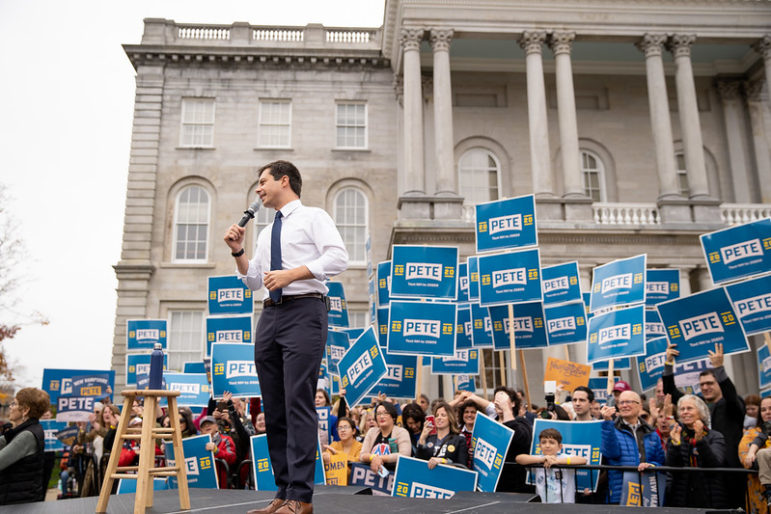
Poverty got a shout out in the run-up to Tuesday’s New Hampshire primary, in the final pre-primary debate last Friday, when moderator George Stephanopoulos asked a question about child poverty. Stephanopoulos noted that it was the first time in 20 years that such a question had worked its way into a presidential debate. Just as remarkable, perhaps, is that it was asked in the state with the lowest poverty rate it 2018. At 7.6 percent. New Hampshire was one of only six states with a poverty rate below 10 percent.
New Hampshire’s small size, rural character and lack of diversity (WalletHub found it to be the fourth least-diverse state) are often cited by people who question the Granite State’s unique and hallowed place in the presidential-campaign calendar. With the national poverty rate at 11.8 percent, add that measure to the argument that New Hampshire is not reflective of the national condition—at least not in a way that’s visible to television cameras and news correspondents who ramble through for a few days every four years.
Look closer, and the situation is more complicated. According to the American Community Survey, 44 of New Hampshire’s 107 cities, towns and villages post poverty rates in excess of the national average. Ten of them have more than one in five people living in poverty. Durham, N.H., has a poverty rate of 33 percent.
“I could drive you to the town of Exeter and you’d be appalled by the mobile homes that are rusting away and hidden in the woods,” Patte-Anne Ardizzoni, the communications director for Southern New Hampshire Services, Inc., tells City Limits. “That story stands for many of the towns.”
Some of the poor are newcomers: Until the number dropped dramatically under President Trump, New Hampshire was seeing a significant number of refugee families every year. But there is multi-generational poverty, too, especially in the northern half of the state: Coos and Grafton counties, which cover the north and west-central parts of the state, have the highest poverty rates among New Hampshire counties, at 13.3 percent and 10.9 percent, respectively.
The death of traditional industry, like paper plants, meant that “people who were once working (and generations had been in the same plants) found themselves without options,” Ardizzoni says. Lack of education—especially adult ed—or transportation options in rural areas compounds the problem. A dearth of workforce housing adds to the strain.
The latter manifests itself in a homelessness problem that, while exponentially smaller than New York City’s, is a significant concern in cities like Manchester, New Hampshire’s largest.
In the past year or so, “We saw a lot of attention paid to homelessness because it was becoming more visible than I’ve ever seen it,” says Cathy Kuhn, the director of the New Hampshire Coalition to End Homelessness. “There were literally people sleeping downtown on Elm Street. It became a key point of discussion for city leadership.” While the city had an emergency shelter system for single adults, it was at capacity. “That was the first time that Manchester has ever had to deal with that.”
Kuhn says Manchester reacted well, convening a task force of stakeholders who crafted a thoughtful response plan. It’s still a work in progress, though. “Thankfully, we’ve been able to come up with a plan that at least on the coldest nights, when sleeping outside could be deadly, there is an overflow facility where our faith community here in the city sort of stepped up to provide that facility, both the space and the staffing.” However, “We don’t have overflow capacity on nights when it’s not cold but people still need shelters. That’s something we’re still working on.”
Family homelessness is also a growing concern. Of the households with children that her organization tracks as homeless, “typically around a third of families are reported living outside cars, basements and other places not meant for human habitation,” Kuhn says. As is the case in New York, families are less visible than street-homeless individuals. “It’s sort of the hidden homeless,” she adds. But the shelter system is simply not up to the task. “There are people getting turned away every single day,” she adds.
Just as disturbing, some of those homeless families have housing vouchers, but they still cannot find an apartment they can afford. “Our vacancy rate is so incredibly low,” Kuhn says. “It’s a landlord’s market.”
Therein lies the larger significance of New Hampshire’s homelessness problem. According to the U.S. Department of Housing and Urban Development’s annual point-in-time count, New Hampshire has the eighth lowest number of homeless people among the states, with just under 1,400 homeless among a total population of 1.4 million. It’s not a huge number of people. But it indicates that even in a state with little poverty, and even amid a long-lasting economic boom, there are people in the U.S.—including working people—unable to afford a place to live. It hints at bigger vulnerabilities: the other families not in the homeless tally but barely balancing their earnings against rent and other essentials.
As in Manchester, the housing emergency facing other New Hampshire cities is small-scale, but real. Nashua, the state’s second-largest city, is also wrestling with a homelessness problem that is growing, slowly but steadily. And Ardizzoni says in Portsmouth, on the coast, “Families, working families, who would otherwise opt to be rent payers are staying at Cross Roads House. Kids get on the school bus outside of the shelter, parents go to full time work, and then return to the shelter.”
Kuhn is optimistic that the collaborative approach taken in Manchester will lead to an adequate policy response. But Ardizzoni worries that other demographic changes—namely, New Hampshire’s graying population as residents age in place or opt to retire there—will complicate the challenges. “The systems and services in place right now, and to include housing, are inadequate to cover the sheer number of those retiring and who will be retiring,” she says.
Housing issues have been uniquely visible during the 2020 presidential race, with most major Democratic candidates proposing plans to create more affordability. Some have explicitly mentioned homelessness. But none did in Friday’s debate at Saint Anselm College, three miles from the largest homeless shelter in America’s least-poor state.










